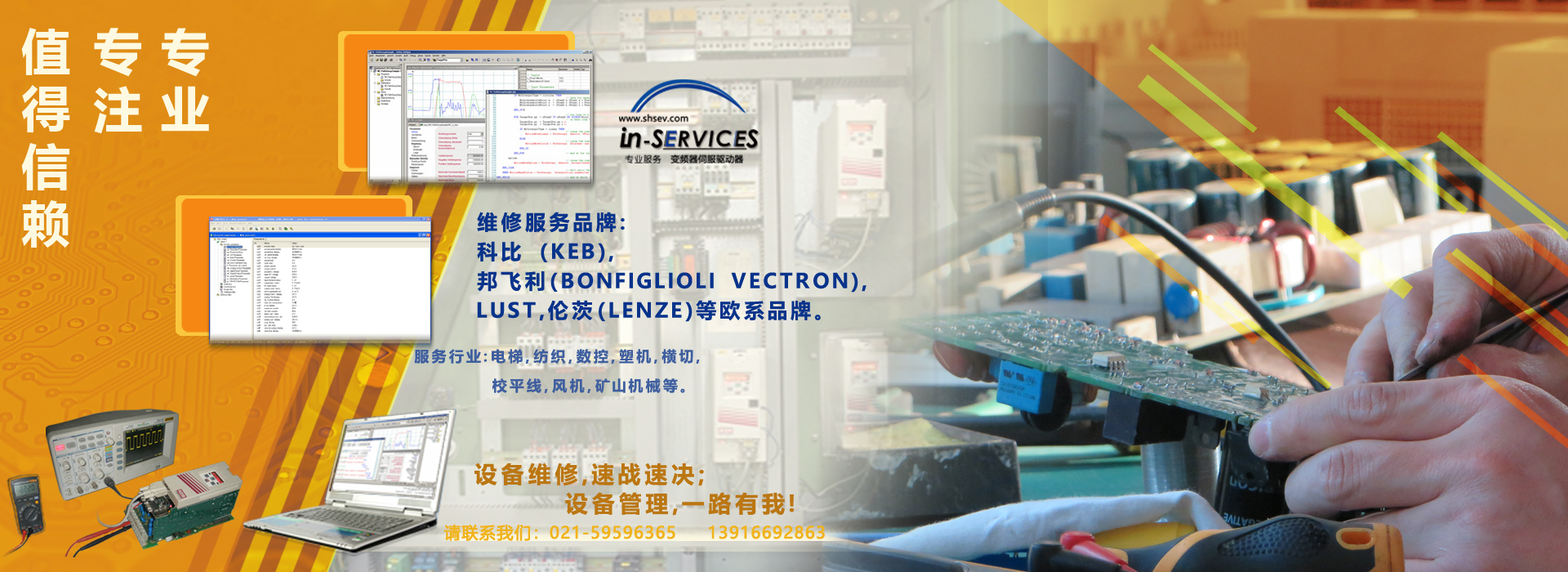
联系人:赵先生
手机:13916692863
电话:021-59596365
传真:021-59596365
邮箱:shsev@163.com
网址:www.shsev.com
地址:上海市嘉定区嘉松北路4777号1号楼306室
Liquid cooled VFDs are just one example of the heatsink technology offered by KEB America. In this post, we will cover the advantages and features of a liquid cooled inverter, and some of the appropriate applications.

KEB drives are offered in both air cooled and liquid cooled options
In order for power electronic components to function properly and perform over a usable lifetime, the heat produced during normal operation must be dissipated. The operational lifetime of these components is directly linked to their operating temperature.
In general, as the operating temperature of power electronic components increases, the lifetime is decreased.
Variable frequency drives (VFDs) utilize various power electronic components. The advantages of using VFD’s open up many application possibilities. These options include applications which may require operation of the system in demanding conditions. High ambient temperatures, high speed and high power are just a few of the conditions that engineers encounter when designing systems. Providing proper cooling for the VFD to operate in these conditions is an important consideration during the design process.
KEB has been working with engineers for many years on demanding VFD applications. One of the many options that KEB offers on their VFDs is a version with a liquid cooled or water cooled heatsink. Utilizing the increased heat dissipation capabilities of liquid over air, the KEB liquid-cooled drives provide a VFD solution for applications that would not be possible, or severely limited, if the only cooling option was air cooling.

Proven technology. KEB has offered liquid cooled VFDs for over 20 years.
High power density. The higher efficiency of the liquid cooling over air cooling to remove heat from the system allows for a physically smaller heatsink design as compared to the same rated power in an air cooled unit. The more compact design reduces required enclosure space freeing up room for other required electrical components.
High switching frequency operation. When running a motor at a high frequency, for example at 800 Hz output, a high switching frequency of the output transistors (e.g. 8 kHz) reduces the current harmonics present in the current waveform delivered to the motor. The lower harmonic levels result in lower rotor heating and more available power from the motor. As the switching frequency increases, so also does the heat generated by the switching losses of the output transistors. As the required output power increases, there becomes a point where air cooling cannot dissipate the heat at a sufficient rate to keep the VFD from overheating. In this case, utilizing a liquid cooled heatsink and the increased heat transfer efficiency of the liquid cooling medium, KEB can provide a solution for the application.
Increased component lifetime. The operating temperature of an air cooled VFD varies with the ambient conditions. As the ambient temperature fluctuates, so does the operating temperature of the internal components. This operating temperature change can cause additional stress on components which may reduce the operation lifetime. Depending on the available liquid cooling medium, the temperature of the cooling medium itself tends to stay more consistent even with changing ambient conditions. Less fluctuation in the inlet temperature to the liquid cooled heatsink results in less of a temperature gradient on the power electronic components. This can help to increase the operation lifetime.
In general, a 10°C reduction in ambient temperature, doubles the operating lifetime of electrical components.
KEB has been producing VFDs utilizing liquid cooled heatsinks for over 20 years. The many demanding applications that KEB has solved using liquid cooled heatsinks have allowed KEB engineers to continually improve and expand the liquid cooling options. KEB is currently on the 3rd generation design of the VFD liquid cooled heatsink. The current version utilizes an extruded aluminum heatsink with a nominal UL (UL test: 5 x nominal pressure = 50 bar) operating pressure of 10 bar (147 psi).

KEB drives can be cooled with water, glycol or other approved coolants
KEB application areas included plastics, textiles, compressors and chillers. Many of these types of applications utilize a refrigerant cooling medium. KEB has tested the VFD liquid cooled heatsink with these cooling mediums. Depending on the type of refrigerant, the only change would be to use seals that are chemically compatible with the required cooling medium.
One of the considerations when using a liquid cooled heatsink is condensation. To help reduce any potential issues in applications that may include high humidity, KEB has developed specific software features for use with the liquid cooled drives.
Heatsink temperature control by external valve control. Included as part of the standard KEB VFD software, the functionality exists to control and external flow valve based on the heatsink temperature, measured directly at the IGBT interface with the liquid cooled heatsink. The KEB software utilizes a PWM (pulse width modulation) control output to control a flow valve on the inlet of the heatsink. The PWM signal is based on a programmable temperature set point as compared to the actual heatsink temperature from the temperature senor located on the heatsink itself. The flow valve is cycled on/off over a programmable cycle time to keep the heatsink temperature at or near the programmable temperature set point. The higher the actual temperature is above the set point, the longer the valve remains open during the cycle time. Conversely, if the actual heatsink temperature is less than the set point temperature, the software function closes the valve and no cooling fluid flows through the heatsink. The set point can then be set to value above the dew point of the surrounding air to reduce the chances of condensation forming on the cooled surface of the heatsink. The flow control function also has the added benefit of reducing the flow requirements during operation when less heat dissipation is required (lower loads, cooler ambient conditions, etc.).

KEB drives feature integrated temperature management for both the drive and liquid cooled motor
The KEB software also includes a second flow control circuit that functions the same as the internal function described above but takes the actual temperature reading from an external KTY temperature sensor. This temperature sensor may be located on a liquid cooled motor allowing the KEB VFD to provide the same flow control and condensation protection for an external device.
While the general requirements for the cooling medium are defined in the KEB manual (free from acids, abrasive substances, solids, etc. – see the KEB liquid cooled manual for a complete specification) there are applications that may require an increased level of corrosion resistance. In this case, KEB had developed a version of the liquid cooled heatsink that utilizes stainless steel cooling channels. These stainless cooling channels are embedded into the machined aluminum heatsink. Due to the decreased heat transfer capability of stainless steel vs aluminum, VFDs utilizing the stainless steel cooling channels must be derated as compared to the standard aluminum cooling channels. Please contact a KEB application engineer for more information on the stainless cooling channel options.
The KEB liquid cooled heatsinks are available in multiple mounting configurations. A chassis mount version is available that would mount the same a standard air-cooled model inside an enclosure. This version may be used for applications that utilize a low inlet temperature such that if a leak were to develop, the cooling fluid would drip to the bottom of the enclosure away from any high voltage connections.
More commonly, KEB utilizes our other liquid cooled mounting option, which is a push-through design. This mounting configuration requires a cutout in the back of the electrical enclosure. The KEB liquid cooled push-through heatsink is designed with a mounting flange which allows the heatsink itself to be pushed through to the outside of the enclosure. A gasket is also available to seal the unit from the outside environment. The mounting configuration separates the liquid connections (outside the enclosure) from the electrical connections (inside the enclosure). Typically this type of mounting configuration is used when the cooling medium pressure is relative high. If a leak were to develop in the cooling hoses or connections, the potential for the cooling medium to spray and come in contact with the electrical connections of the drive would be high. By separating the connections the potential for damage to the drive due to a leak in the cooling system is minimized.

The flanged version allows the coolant connections to be made outside the electrical enclosure
Many applications utilizing VFDs require the use of braking resistors to dissipate regenerative energy during the operational cycle. KEB liquid cooled heatsinks have the option of having resistors mounted directly to the heatsink of the drive. The electrical connections to the braking transistor is done internally in the drive and no field wiring is required. This configuration allows for a much more compact solution saving valuable space in the enclosure.
VFDs with liquid cooled heatsinks provide an alternative solution for demanding applications. If a suitable cooling medium is available, using a VFD with a liquid cooled heatsink may allow for a physically smaller system and may also eliminate the need for external cooling devices needed when using air cooled VFDs (air conditioners or enclosure fans, for example). Liquid cooled drives can be a good option for environments that contain small metal shavings or fibers that can clog a finned heatsink. In addition to the KEB air cooled VFD lines, the option of liquid cooling for the KEB line of VFDs gives us another tool to solve your applications.


